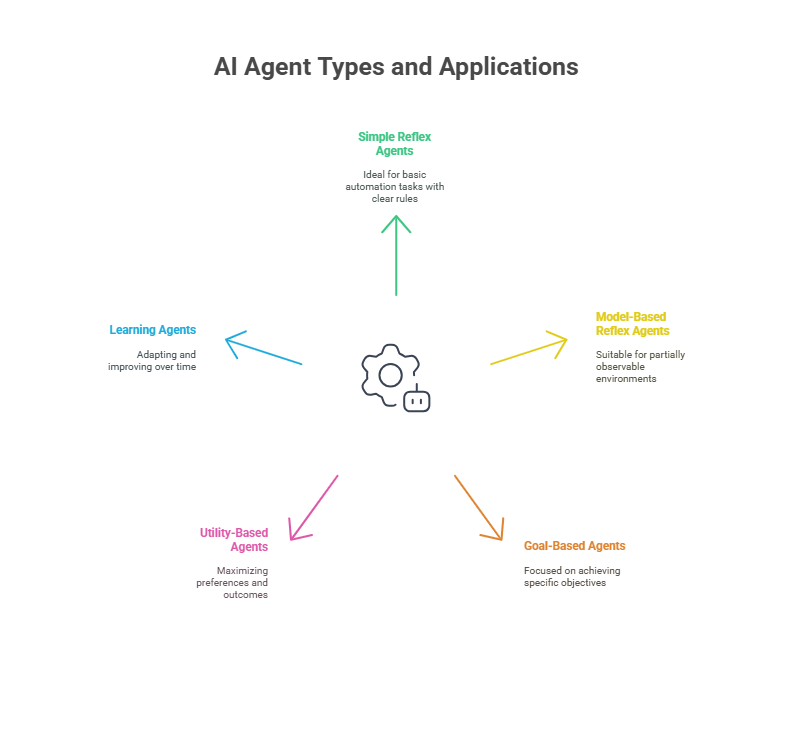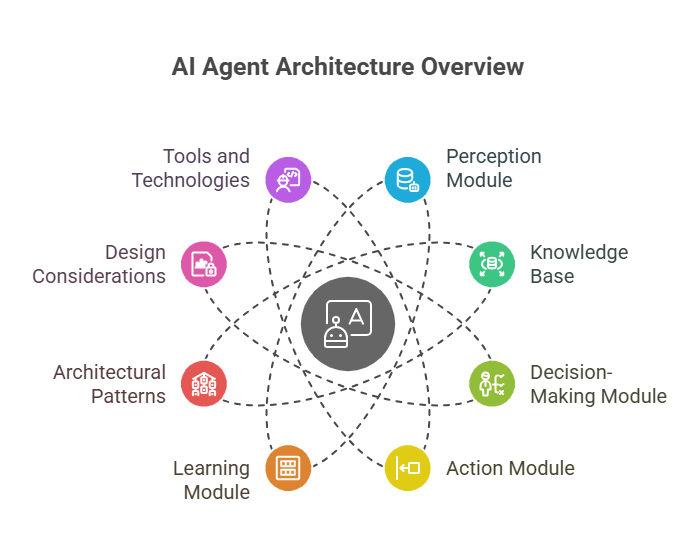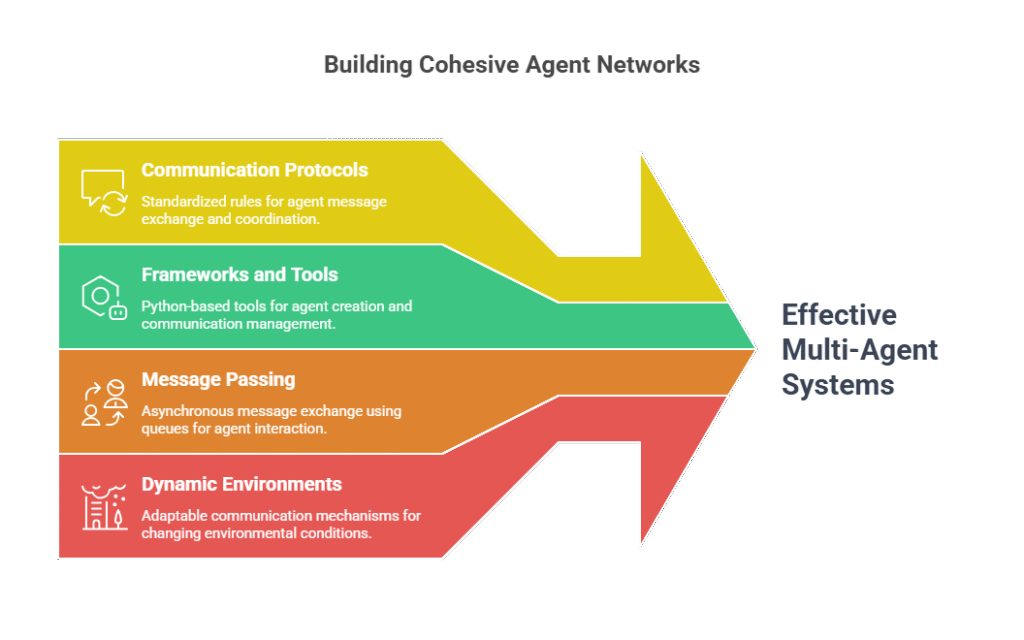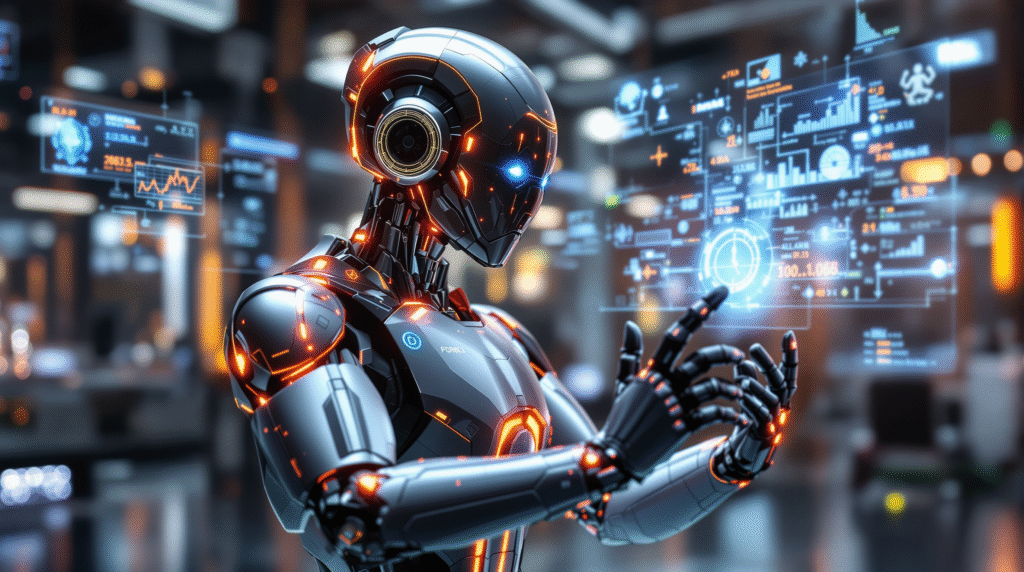Introduction: The Rise of AI Agents
The world of software development is constantly evolving, and one of the most exciting trends is the rise of AI agents. These intelligent entities are transforming how we approach automation, problem-solving, and even creativity in coding. AI agents are no longer a futuristic concept; they are becoming an integral part of modern applications and workflows.
What are AI Agents?
At their core, AI agents are autonomous entities designed to perceive their environment, make decisions, and take actions to achieve specific goals. Unlike traditional software programs that follow predefined rules, AI agents can learn from data, adapt to changing circumstances, and even exhibit human-like reasoning.
Why the Sudden Interest?
Several factors have contributed to the growing interest in AI agents:
Advancements in Machine Learning: The rapid progress in machine learning, particularly deep learning, has provided the tools and techniques necessary to build more sophisticated and capable AI agents.
Availability of Data: AI agents thrive on data, and the increasing availability of large datasets has fueled their development.
Increased Computing Power: Training complex AI models requires significant computing power, which is now more accessible thanks to cloud computing and specialized hardware.
Demand for Automation: Businesses are constantly seeking ways to automate tasks, improve efficiency, and gain a competitive edge. AI agents offer a powerful solution for automating complex and dynamic processes.
The Impact on Software Development
AI agents are already making a significant impact on software development:
Automated Code Generation: AI agents can assist developers by generating code snippets, suggesting improvements, and even writing entire functions.
Intelligent Debugging: AI agents can analyze code for potential errors, identify performance bottlenecks, and suggest solutions.
Personalized Development Environments: AI agents can learn a developer’s coding style and preferences, providing personalized recommendations and assistance.
Automated Testing: AI agents can generate test cases, execute tests, and analyze results, freeing up developers to focus on more creative tasks.
Looking Ahead
As AI technology continues to advance, we can expect to see even more innovative applications of AI agents in software development. From intelligent assistants that guide developers through complex projects to autonomous systems that manage entire software deployments, the possibilities are endless. The rise of AI agents is not just a trend; it’s a fundamental shift in how we approach software development, and it’s one that promises to transform the industry for years to come.
Understanding AI Agents: Concepts and Types
To build effective AI agents, it’s essential to understand what they are, how they function, and the different types that exist. This foundational knowledge helps developers design agents that are well-suited to their specific tasks and environments.
What Is an AI Agent?
An AI agent is a software entity that perceives its environment through sensors, processes information, and acts autonomously to achieve specific goals. Unlike traditional programs that follow fixed instructions, AI agents can learn, adapt, and make decisions based on data and experience.
Key Characteristics of AI Agents
Autonomy: AI agents operate without constant human intervention, making decisions and taking actions independently.
Reactivity: They perceive changes in their environment and respond promptly.
Proactiveness: Beyond reacting, AI agents can take initiative to achieve long-term objectives.
Social Ability: Some agents can communicate and collaborate with other agents or humans.
Types of AI Agents
Simple Reflex Agents: These agents act solely based on the current percept, using condition-action rules. They do not consider the history of past states.
Model-Based Reflex Agents: These maintain an internal state to keep track of the world, allowing them to handle partially observable environments.
Goal-Based Agents: These agents act to achieve specific goals, evaluating possible actions based on their outcomes.
Utility-Based Agents: They not only aim for goals but also consider preferences, choosing actions that maximize a utility function.
Learning Agents: These agents improve their performance over time by learning from experience, adapting to new situations.
AI Agents in Practice
AI agents can be found in various applications, such as virtual assistants, recommendation systems, autonomous vehicles, and game characters. Their design depends on the complexity of the task, the environment, and the desired level of autonomy.
Why Understanding Types Matters
Choosing the right type of AI agent is crucial for success. For example, a simple reflex agent might suffice for a basic automation task, while a learning agent is better suited for dynamic, complex environments where adaptation is necessary.

Defining the Purpose and Scope of Your AI Agent
Before diving into development, it is crucial to clearly define the purpose and scope of your AI agent. This step sets the foundation for all subsequent design and implementation decisions, ensuring that the agent effectively addresses the intended problem.
Identifying the Problem to Solve
Start by pinpointing the specific task or challenge your AI agent will tackle. This could range from automating repetitive programming tasks, providing intelligent code suggestions, managing workflows, or even interacting with users in a conversational manner. A well-defined problem statement helps focus development efforts and avoid scope creep.
Setting Clear Objectives
Outline what success looks like for your AI agent. Objectives should be specific, measurable, achievable, relevant, and time-bound (SMART). For example, an objective might be to reduce code review time by 30% within six months using an AI-powered assistant.
Determining the Agent’s Capabilities
Based on the problem and objectives, decide on the functionalities your AI agent needs. Will it require natural language understanding, decision-making abilities, learning from user feedback, or integration with external APIs? Defining capabilities early helps in selecting appropriate technologies and frameworks.
Defining the Scope and Boundaries
Clarify what your AI agent will and will not do. Setting boundaries prevents overcomplicating the agent and helps manage user expectations. For instance, an AI agent designed for code suggestions might not handle debugging or deployment tasks initially.
Understanding the Environment
Consider the environment in which your AI agent will operate. Is it a standalone desktop application, a web service, or embedded within an integrated development environment (IDE)? The environment influences design choices such as communication protocols, user interface, and resource constraints.
Stakeholder Involvement
Engage with potential users, developers, and other stakeholders to gather requirements and feedback. Their insights can reveal practical needs and constraints that shape the agent’s purpose and scope.
Documenting Requirements
Create a clear and concise requirements document summarizing the purpose, objectives, capabilities, scope, and environment. This document serves as a reference throughout the development lifecycle and facilitates communication among team members.
Designing the Architecture of an AI Agent
Designing a robust and scalable architecture is a key step in building an effective AI agent. The architecture defines how the agent’s components interact, process information, and deliver functionality, ensuring that the system meets performance, maintainability, and extensibility requirements.
Core Components of AI Agent Architecture
Perception Module
This component gathers data from the environment through sensors or input interfaces. It processes raw data into a format the agent can understand, such as text, images, or structured data.
Knowledge Base / Memory
The agent stores relevant information, past experiences, and learned models here. This memory enables the agent to make informed decisions and adapt over time.
Decision-Making Module
Using the processed data and knowledge base, this module determines the best action to take. It may employ rule-based systems, machine learning models, or planning algorithms.
Action Module
This component executes the chosen actions, which could involve sending commands, generating outputs, or interacting with other systems.
Learning Module (Optional)
For adaptive agents, this module enables continuous learning from new data and feedback, improving performance over time.
Architectural Patterns
Layered Architecture
Separates perception, decision-making, and action into distinct layers, promoting modularity and easier maintenance.
Agent-Environment Interaction Loop
The agent continuously perceives the environment, decides, acts, and updates its knowledge, forming a feedback loop essential for autonomy.
Microservices Architecture
For complex agents, components can be implemented as independent services communicating via APIs, enhancing scalability and flexibility.
Design Considerations
Scalability:
Ensure the architecture can handle increasing data volumes and complexity without performance degradation.
Modularity:
Design components to be loosely coupled, allowing independent development, testing, and replacement.
Fault Tolerance:
Incorporate mechanisms to handle errors gracefully and maintain agent functionality.
Interoperability:
Plan for integration with external systems, APIs, and other agents.
Security and Privacy:
Protect sensitive data and ensure secure communication, especially when agents operate in distributed environments.
Tools and Technologies
Selecting appropriate frameworks and tools can simplify architectural implementation. Popular choices include Python-based frameworks like TensorFlow or PyTorch for learning modules, REST or gRPC for communication, and containerization tools like Docker for deployment.

Implementing AI Agents: Tools and Frameworks
Implementing AI agents requires selecting the right tools and frameworks that align with your project’s goals, technical requirements, and team expertise. The choice of technology influences development speed, scalability, and the agent’s capabilities.
Popular Programming Languages
Python:
The most widely used language for AI development due to its simplicity and rich ecosystem of libraries. Python supports rapid prototyping and has extensive support for machine learning, natural language processing, and data manipulation.
Java:
Known for its portability and robustness, Java is often used in large-scale enterprise applications and supports multi-agent system frameworks.
C++:
Offers high performance and control over system resources, suitable for real-time AI agents and embedded systems.
Key Libraries and Frameworks
Machine Learning and Deep Learning:
TensorFlow, PyTorch, scikit-learn, and Keras provide tools for building and training models that power AI agents.
Multi-Agent System Frameworks:
Mesa (Python) is a popular framework for simulating and developing multi-agent systems. JADE (Java Agent DEvelopment Framework) supports building agent-based applications with communication capabilities.
Natural Language Processing (NLP):
Libraries like spaCy, NLTK, and Transformers (by Hugging Face) enable AI agents to understand and generate human language.
Reinforcement Learning:
Frameworks such as OpenAI Gym and Stable Baselines facilitate training agents that learn optimal behaviors through interaction with environments.
Microservices and Deployment Tools
Docker and Kubernetes:
Containerization and orchestration tools help deploy AI agents as scalable, independent services.
API Frameworks:
FastAPI and Flask (Python) allow building RESTful APIs for agent communication and integration.
Development Best Practices
Version Control:
Use systems like Git to manage code changes and collaborate effectively.
Experiment Tracking:
Tools like MLflow or Weights & Biases help monitor model training and performance.
Testing:
Implement unit and integration tests to ensure reliability.
Training, Testing, and Deploying AI Agents
Building an effective AI agent involves not only designing and implementing it but also carefully training, testing, and deploying the model to ensure it performs well in real-world scenarios.
Training AI Agents
Training involves feeding data to the agent’s learning algorithms so it can recognize patterns, make decisions, or predict outcomes. Depending on the agent type, training methods may include supervised learning, reinforcement learning, or unsupervised learning.
Key steps in training:
Data Preparation: Clean, preprocess, and format data suitable for training.
Model Selection: Choose appropriate algorithms or architectures.
Training Process: Run training iterations, tuning hyperparameters for optimal performance.
Validation: Use validation datasets to monitor overfitting and generalization.
Testing AI Agents
Testing evaluates the agent’s performance on unseen data or in simulated environments. It helps identify weaknesses, biases, or errors before deployment.
Testing strategies include:
Unit Testing: Verify individual components.
Integration Testing: Ensure components work together.
Performance Testing: Measure accuracy, speed, and resource usage.
User Acceptance Testing: Validate the agent meets user needs.
Deploying AI Agents
Deployment makes the AI agent available for real-world use. It involves packaging the model, setting up infrastructure, and integrating with existing systems.
Considerations for deployment:
Scalability: Ensure the system can handle expected load.
Monitoring: Track agent performance and detect anomalies.
Updating: Plan for model retraining and versioning.
Security: Protect data and access.
Python Code Example: Simple AI Agent Training and Deployment Pipeline
Below is a minimal example demonstrating training a classification model with scikit-learn, testing it, and exposing it via a simple API using FastAPI.
python
from fastapi import FastAPI
from pydantic import BaseModel
from sklearn.datasets import load_iris
from sklearn.model_selection import train_test_split
from sklearn.ensemble import RandomForestClassifier
from sklearn.metrics import accuracy_score
import joblib
# 1. Data Preparation
iris = load_iris()
X_train, X_test, y_train, y_test = train_test_split(
iris.data, iris.target, test_size=0.2, random_state=42
)
# 2. Model Training
model = RandomForestClassifier(n_estimators=100, random_state=42)
model.fit(X_train, y_train)
# 3. Testing
y_pred = model.predict(X_test)
accuracy = accuracy_score(y_test, y_pred)
print(f"Test Accuracy: {accuracy:.2f}")
# 4. Save the model
joblib.dump(model, "iris_model.joblib")
# 5. Deploy with FastAPI
app = FastAPI()
class IrisFeatures(BaseModel):
sepal_length: float
sepal_width: float
petal_length: float
petal_width: float
# Load model at startup
model = joblib.load("iris_model.joblib")
@app.post("/predict")
def predict(features: IrisFeatures):
data = [[
features.sepal_length,
features.sepal_width,
features.petal_length,
features.petal_width,
]]
prediction = model.predict(data)
species = iris.target_names[prediction[0]]
return {"predicted_species": species}
# To run the API:
# uvicorn filename:app –reloadBest Practices for Collaboration Between Developers and Data Scientists
Effective collaboration between developers and data scientists is essential for building successful AI agents. Each group brings unique skills and perspectives, and aligning their efforts ensures that AI solutions are both technically sound and practically useful.
1. Establish Clear Communication Channels
Open and frequent communication helps prevent misunderstandings and keeps everyone aligned. Use tools like Slack, Microsoft Teams, or project management platforms to facilitate discussions and updates.
2. Define Shared Goals and Metrics
Agree on the objectives of the AI agent and how success will be measured. Shared goals foster teamwork and provide a clear direction for both development and data science efforts.
3. Use Version Control and Experiment Tracking
Employ version control systems (e.g., Git) for code and data pipelines. Use experiment tracking tools like MLflow or Weights & Biases to log model parameters, results, and iterations, enabling reproducibility and transparency.
4. Adopt Modular and Reusable Code Practices
Write modular code with clear interfaces so that data scientists can focus on modeling while developers handle integration and deployment. This separation of concerns speeds up development and reduces conflicts.
5. Regularly Review and Test Models
Schedule code and model reviews involving both teams. Testing models in realistic scenarios helps identify issues early and ensures the AI agent meets quality standards.
6. Foster a Culture of Continuous Learning
Encourage knowledge sharing through workshops, documentation, and pair programming. Understanding each other’s domains improves collaboration and innovation.
7. Align on Deployment and Monitoring Strategies
Plan together how models will be deployed, monitored, and updated. Developers can set up infrastructure and monitoring tools, while data scientists provide insights on model behavior and retraining needs.
Python Code Example: Logging Experiments with MLflow
Here is a simple example demonstrating how data scientists and developers can log model training experiments using MLflow for better collaboration and tracking.
python
import mlflow
import mlflow.sklearn
from sklearn.datasets import load_iris
from sklearn.model_selection import train_test_split
from sklearn.ensemble import RandomForestClassifier
from sklearn.metrics import accuracy_score
# Load data
iris = load_iris()
X_train, X_test, y_train, y_test = train_test_split(
iris.data, iris.target, test_size=0.2, random_state=42
)
# Start MLflow experiment
mlflow.set_experiment("Iris_Classification")
with mlflow.start_run():
# Train model
model = RandomForestClassifier(n_estimators=100, random_state=42)
model.fit(X_train, y_train)
# Predict and evaluate
y_pred = model.predict(X_test)
accuracy = accuracy_score(y_test, y_pred)
# Log parameters and metrics
mlflow.log_param("n_estimators", 100)
mlflow.log_metric("accuracy", accuracy)
# Log model
mlflow.sklearn.log_model(model, "model")
print(f"Logged model with accuracy: {accuracy:.2f}")Challenges and Limitations of AI Agents
While AI agents offer powerful capabilities, their development and deployment come with several challenges and limitations that developers and organizations must carefully consider.
1. Complexity of Design and Implementation
Building AI agents involves integrating multiple components such as perception, decision-making, learning, and communication. Designing these to work seamlessly requires expertise in AI, software engineering, and domain knowledge, which can be resource-intensive.
2. Data Quality and Availability
AI agents rely heavily on data for training and decision-making. Poor quality, biased, or insufficient data can lead to inaccurate or unfair agent behavior, limiting effectiveness and trustworthiness.
3. Scalability Issues
As the number of agents or the complexity of their environment grows, maintaining performance and coordination becomes challenging. Scalability requires careful architectural design and efficient algorithms.
4. Interpretability and Explainability
Many AI models, especially deep learning-based agents, operate as “black boxes,” making it difficult to understand or explain their decisions. This lack of transparency can hinder debugging, trust, and regulatory compliance.
5. Security and Privacy Concerns
AI agents often handle sensitive data and interact with critical systems. Ensuring secure communication, protecting data privacy, and defending against adversarial attacks are ongoing challenges.
6. Ethical and Legal Considerations
Autonomous agents may make decisions with significant consequences. Addressing ethical issues such as fairness, accountability, and compliance with laws is essential but complex.
7. Integration with Legacy Systems
Deploying AI agents in existing infrastructures can be difficult due to compatibility issues, requiring additional effort for integration and testing.
8. Maintenance and Continuous Learning
AI agents may require ongoing updates and retraining to adapt to changing environments or requirements. Managing this lifecycle demands dedicated resources and processes.
Multi-Agent Systems: Collaboration and Competition
Multi-Agent Systems (MAS) consist of multiple AI agents interacting within a shared environment. These agents can either collaborate to achieve common goals or compete when their objectives conflict, leading to complex and dynamic behaviors.
1. Introduction to Multi-Agent Systems (MAS)
MAS are systems where multiple autonomous agents operate simultaneously, each with its own goals and capabilities. They are useful for solving problems that are too complex for a single agent, such as distributed control, resource allocation, and simulation of social behaviors.
2. Collaboration Among Agents
Collaboration enables agents to share information, coordinate actions, and divide tasks to improve overall system performance. Techniques include joint planning, task allocation, and consensus algorithms. Effective collaboration often requires communication protocols and shared knowledge bases.
3. Competition and Conflict Resolution
Agents may have conflicting interests, leading to competition. Game theory provides tools to model and analyze such interactions, helping design strategies for negotiation, bidding, or conflict resolution. Mechanisms like auctions or voting can be used to resolve disputes.
4. Communication and Coordination Mechanisms
Communication is vital for both collaboration and competition. Agents may communicate directly via messages or indirectly through the environment (stigmergy). Coordination strategies include centralized control, distributed consensus, and market-based approaches.
5. Applications of Multi-Agent Systems
MAS are applied in various domains such as traffic management, robotics, distributed sensor networks, and online marketplaces. Their ability to handle dynamic and decentralized environments makes them suitable for complex real-world problems.
6. Tools and Frameworks for MAS Development
Python libraries like Mesa facilitate the simulation and development of MAS. Other frameworks include JADE (Java) and SPADE (Python), which provide communication and agent lifecycle management features.
7. Challenges in MAS Design
Designing MAS involves addressing scalability, robustness, and ensuring coherent global behavior from local agent actions. Balancing autonomy and coordination is critical to avoid conflicts and inefficiencies.
8. Conclusion
Multi-Agent Systems offer a powerful paradigm for building distributed AI applications where agents collaborate or compete. Understanding their dynamics and leveraging appropriate tools is key to harnessing their full potential.
Communication Between Agents: Protocols and Frameworks
Effective communication is a cornerstone of multi-agent systems, enabling individual agents to exchange information, coordinate their actions, and achieve collective goals. Communication between agents can take various forms, including direct message passing or indirect interaction through a shared environment. Direct communication involves explicit sending and receiving of messages, while indirect communication, often called stigmergy, relies on agents modifying the environment to influence others.
To ensure meaningful exchanges, agents follow established communication protocols that define the syntax, semantics, and timing of messages. Common protocols include request-response patterns, where one agent asks for information or action and another replies, and publish-subscribe models, where agents broadcast messages to interested parties without direct addressing. These protocols help maintain order and predictability in interactions, especially in complex or dynamic environments.
Frameworks and tools have been developed to facilitate agent communication and management. For example, SPADE (Smart Python multi-Agent Development Environment) is a Python-based framework that supports agent creation, communication, and lifecycle management using the XMPP protocol. It provides abstractions for message handling, agent behaviors, and asynchronous communication, making it easier to build scalable and robust multi-agent applications.
A simple example of agent communication in Python can be demonstrated using queues to simulate message passing. Agents place messages into a shared queue and retrieve messages intended for them, enabling asynchronous and decoupled interaction. This approach, while basic, illustrates the fundamental concept of message exchange and can be extended with more sophisticated protocols and error handling.
In dynamic environments, the choice of communication protocols and frameworks significantly impacts the efficiency and reliability of multi-agent systems. Properly designed communication mechanisms enable agents to negotiate, coordinate, and adapt to changing conditions, ultimately enhancing the system’s overall performance and resilience.

Conclusion: Integrating AI Agents with Microservices and Beyond
The integration of AI agents with microservices architecture represents a significant advancement in building scalable, flexible, and intelligent software systems. By encapsulating AI agents as microservices, organizations can leverage the benefits of modularity, independent deployment, and easier maintenance while harnessing the autonomous capabilities of AI agents to perform complex tasks.
Throughout this exploration, we have seen how AI agents bring autonomy, adaptability, and intelligence to software applications, enabling automation, decision-making, and enhanced user experiences. Microservices complement these strengths by providing a robust architectural framework that supports scalability, fault isolation, and continuous delivery. Together, they form a powerful synergy that addresses many challenges faced by modern software development.
However, successful integration requires careful design considerations, including defining clear agent responsibilities, ensuring statelessness where possible, and establishing effective communication protocols. Collaboration between developers, data scientists, and system architects is crucial to align goals, manage data flows, and maintain system reliability.
The journey also highlighted the importance of tools and frameworks that facilitate the development, deployment, and monitoring of AI agents within microservices ecosystems. Python’s rich ecosystem, including libraries for AI, communication, and microservices frameworks, provides a solid foundation for building such systems.
Looking forward, the future of AI agents integrated with microservices is promising, with emerging trends such as distributed AI, edge computing, and self-adaptive systems poised to further enhance capabilities. Challenges remain in areas like security, interpretability, and ethical considerations, underscoring the need for ongoing research and best practices.
AI Agents: Building intelligent applications with ease
From Pull Request to Deployment: AI Agents in the Review Process
AI Agents in Practice: Automating a Programmer’s Daily Tasks


